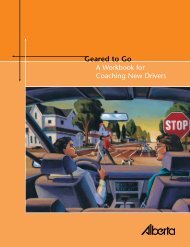Commercial driver's guide to operation, safety and licensing
Commercial driver's guide to operation, safety and licensing
Commercial driver's guide to operation, safety and licensing
Create successful ePaper yourself
Turn your PDF publications into a flip-book with our unique Google optimized e-Paper software.
IF WEIGHT<br />
IS DOUBLED<br />
BRAKING FORCE<br />
MUST BE DOUBLED<br />
IF SPEED<br />
IS DOUBLED<br />
BRAKING FORCE MUST<br />
BE INCREASED 4 TIMES<br />
IF WEIGHT AND<br />
SPEED ARE DOUBLED<br />
Figure 1<br />
Figure 2<br />
BRAKING FORCE MUST<br />
BE INCREASED 8 TIMES<br />
Figure 3<br />
attention <strong>to</strong> driving, or is not feeling<br />
well physically or mentally. Perception<br />
distance is how far a vehicle travels<br />
during this time.<br />
2 Driver reaction time is the amount of<br />
time it takes between deciding <strong>to</strong> s<strong>to</strong>p<br />
<strong>and</strong> actually applying pressure <strong>to</strong> the<br />
brake pedal. Normal driver reaction time<br />
is about three quarters of a second.<br />
Reaction time will be slower if the driver:<br />
• is tired, or<br />
• has been drinking alcohol or<br />
using drugs<br />
Reaction distance is how far a vehicle<br />
travels during this time.<br />
3 Lag time is the amount of time it takes<br />
for the air brake system <strong>to</strong> respond after<br />
the driver has applied pressure on the<br />
brake pedal. Air brakes do not respond<br />
immediately because it takes time for<br />
the compressed air <strong>to</strong> flow through the<br />
system <strong>and</strong> apply the brakes which<br />
takes about 4/10 of a second. Lag time<br />
distance is how far a vehicle travels<br />
during this time.<br />
4 Braking time is the amount of time<br />
it takes for the vehicle <strong>to</strong> come <strong>to</strong> a<br />
complete s<strong>to</strong>p after the brakes have<br />
been applied. Braking time depends on:<br />
• the force with which the brakes<br />
are applied<br />
• the condition of the brake<br />
linings <strong>and</strong> drums<br />
• the traction of the tires on<br />
the road surface<br />
• the vehicle weight <strong>and</strong> speed<br />
Braking distance is how far a vehicle<br />
travels during this time.<br />
Total s<strong>to</strong>pping distance is the<br />
sum of perception distance, reaction<br />
distance, lag time distance <strong>and</strong><br />
braking distance.<br />
Another fac<strong>to</strong>r involved in s<strong>to</strong>pping<br />
distances is the slope or grade of the road.<br />
A vehicle travelling down a hill will need a<br />
longer s<strong>to</strong>pping distance than a vehicle<br />
travelling at the same speed on a level<br />
surface because of the effect of gravity.<br />
A vehicle travelling up a hill will s<strong>to</strong>p in a<br />
shorter distance than a vehicle travelling<br />
the same speed on a level surface, again<br />
because of the effect of the grade.<br />
General braking<br />
information<br />
• When applying the brakes, press down<br />
the pedal using an even pressure <strong>and</strong><br />
then ease off the pedal as the vehicle<br />
slows down. Just before the s<strong>to</strong>p,<br />
release the brakes <strong>to</strong> avoid a sudden<br />
jerk or rebound. Then apply pressure<br />
<strong>to</strong> the brake pedal again <strong>to</strong> hold the<br />
vehicle while it is s<strong>to</strong>pped.<br />
• Do not pump (alternately applying <strong>and</strong><br />
then releasing) the air brakes as this will<br />
42 A <strong>Commercial</strong> Driver’s Guide <strong>to</strong> Operation, Safety <strong>and</strong> Licensing




